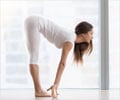New research shows that higher body flexibility, measured by the Flexindex, is linked to better survival rates in middle-aged individuals.
- Higher Flexindex scores are associated with lower mortality risk
- Women generally have better flexibility scores than men
- Incorporating flexibility exercises may improve longevity
Reduced Body Flexibility Is Associated With Poor Survival in Middle-Aged Men and Women: A Prospective Cohort Study
Go to source). Flexibility, defined as the range of motion around joints and muscles, plays a pivotal role in overall health and mobility. The study introduces a novel metric called the Flexindex, which evaluates body flexibility through a series of joint movements. The findings suggest that higher flexibility levels are associated with better survival rates, emphasizing the significance of incorporating flexibility exercises into regular physical activity routines.
Women with higher flexibility scores have a 4.78 times lower risk of dying compared to those with lower scores. #medindia #flexibility #aging’
Flexindex Scores and Their Impact on Mortality and Longevity
Researchers from the Exercise Medicine Clinic – CLINIMEX in Rio de Janeiro, Brazil, conducted an extensive study analyzing data from 3,139 middle-aged participants (66% men) aged 46-65 years. The aim was to assess how flexibility impacts longevity and overall health. Participants underwent a flexibility test, known as the "Flexitest," which measured the range of motion in 20 different joint movements, resulting in a composite score called Flexindex.1. Flexindex Scores and Gender Differences:
- The average Flexindex score was found to be 35% higher in women compared to men.
- This score is derived from a combination of the passive range of motion in various joints, with a scoring range from 0 to 80. Higher scores indicate better flexibility.
- During an average follow-up period of 12.9 years, 302 participants (9.6%) died. The study revealed an inverse relationship between Flexindex scores and mortality risk.
- Individuals with higher Flexindex scores had a significantly lower risk of dying. Specifically, those with lower Flexindex scores had a 1.87 times higher risk of dying in men and a 4.78 times higher risk in women compared to those with higher scores.
- The study highlights that good flexibility is associated with better survival rates, adding to the existing evidence that aerobic fitness and strength contribute to longevity.
- Researchers suggest that reduced flexibility may contribute to poorer survival outcomes, emphasizing the need for flexibility exercises as a part of routine physical activity.
Importance of Flexibility in Aging
Maintaining good flexibility is crucial for overall health, as it helps prevent pain, improves movement efficiency, and reduces the risk of injuries. As people age, their flexibility tends to decrease, which can impact their quality of life and mobility.1. Impact on Daily Life:
- Reduced flexibility can lead to muscle stiffness, joint pain, and limited mobility. For instance, tight hamstrings can cause discomfort in the thighs and lower back, affecting daily activities and overall comfort.
- Flexibility exercises can help alleviate pain, improve posture, and enhance physical performance. Regular stretching can also support cardiovascular health and reduce the risk of conditions like type 2 diabetes.
Practical Tips for Improving Flexibility
Incorporating flexibility exercises into your daily routine can yield significant benefits for overall health and longevity. Some effective stretches to enhance flexibility are:1. Hip Hug Stretch: Sit on the floor with one leg extended and the other leg bent with the foot placed on the inner thigh of the extended leg. Gently lean forward, reaching towards the toes of the extended leg. Hold for 20-30 seconds and switch sides (2✔ ✔Trusted Source
Hip Hug Stretch
Go to source).
2. Half-Kneeling Hip Flexor Stretch: Kneel on one knee with the other foot placed in front, forming a 90-degree angle. Push your hips forward gently while keeping your back straight. Hold for 20-30 seconds and switch sides (3✔ ✔Trusted Source
Four Hip Flexor Stretches to Relieve Tightness, from a PT
Go to source).
3. Calf Stretch at a Wall: Stand facing a wall with one foot in front of the other. Place your hands on the wall for support and lean forward, keeping the back leg straight and the heel on the ground. Hold for 20-30 seconds and switch sides (4✔ ✔Trusted Source
Wall Calf Stretch
Go to source).
While the study presents promising findings about the relationship between flexibility and longevity, more research is needed to establish flexibility as a standard component of health assessments. The study's authors and experts suggest that incorporating flexibility exercises into daily routines, especially for older adults, can be beneficial. However, further studies are necessary to confirm these results and understand the underlying mechanisms better.
The recent study underscores the importance of flexibility in maintaining health and extending longevity. As flexibility tends to decrease with age, incorporating stretching and flexibility exercises into daily routines can have significant benefits. Regular assessments of flexibility may become an essential part of health evaluations, helping individuals enhance their overall well-being and improve their chances of living a longer, healthier life.
References:
- Reduced Body Flexibility Is Associated With Poor Survival in Middle‐Aged Men and Women: A Prospective Cohort Study - (https://onlinelibrary.wiley.com/doi/epdf/10.1111/sms.14708)
- Hip Hug Stretch - (https://fitfxtraining.ca/stretching-mobility-exercises/hip-hug-stretch)
- Four Hip Flexor Stretches to Relieve Tightness, from a PT - (https://www.hss.edu/article_hip-flexor-stretch.asp)
- Wall Calf Stretch - (https://www.rehabhero.ca/exercise/wall-calf-stretch)
Source-Medindia











